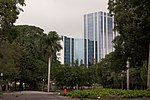Central do Brasil
Art Deco architecture in BrazilBrazil transport stubsBrazilian building and structure stubsMetrô Rio stationsSouth American railway station stubs ... and 2 more
SuperVia stationsTransport infrastructure completed in 1937

Central do Brasil (Portuguese pronunciation: [sẽˈtɾaw du bɾaˈziw]) is a major train station in the Brazilian city of Rio de Janeiro. It is the last stop of Rio's railway network, as well as a hub for connection with the city subway and a bus station. Central do Brasil was also a preeminent stop in the interstate Central do Brasil railroad, which linked Rio de Janeiro with São Paulo and Minas Gerais, though the railroad is now deactivated. The station is located in downtown Rio de Janeiro, along the Avenida Presidente Vargas and across from the Campo de Santana park. It was built in Art deco style.
Excerpt from the Wikipedia article Central do Brasil (License: CC BY-SA 3.0, Authors, Images).Central do Brasil
Terminal Rodoviário Procópio Ferreira, Rio de Janeiro Centro (Zona Central do Rio de Janeiro)
Geographical coordinates (GPS) Address Website External links Nearby Places Show on map
Geographical coordinates (GPS)
| Latitude | Longitude |
|---|---|
| N -22.903413888889 ° | E -43.191444444444 ° |
Address
Central do Brasil
Terminal Rodoviário Procópio Ferreira
20221-250 Rio de Janeiro, Centro (Zona Central do Rio de Janeiro)
Rio de Janeiro, Brazil
Open on Google Maps








